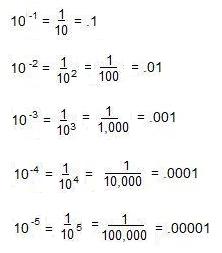



Some Helpful Tools
Math: Scientific Notation - Tutorial
This section will cover the fundamentals of scientific notation.
Positive Exponents


Scientific notation uses the base of 10 to write extremely large or extremely small numbers.
The positive exponents tell how many zeros will be added to the base number.
Negative Exponents
Number System Chart
Negative exponents show a reciprocal value, which is the flip-flop or opposite of a whole number.
Therefore, the smaller the exponent, the smaller the number.
Example 1:
Remember, 10 can be written in fraction form as:

1 divided by 10 is .01
Example 2:
Practice Writing in Scientific Notation
point has been moved. We see that there are seven spaces.
Suppose you want to write 93,731,000 in scientific notation. Since our example is a positve number, you will begin by:
- placing a decimal point between the 9 and 3
- then, multiply by 10
- Count all of the spaces from the decimal point to where the decimal
Example 1:
Example 2:
What is .0000713 in scientific notation?
- Place a decimal point between the 7 and 1.
- Multiply by 10.
- Count all of the spaces from the decimal point to where the decimal
point has been moved. There are five spaces.
The exponent 5 is negative.
When the exponent is negative, the decimal point is moved to the right, resulting in
a smaller number.
The exponent 7 is positive.
When the exponent is positive, the decimal point is moved to the left, resulting in a larger number.
Scientific notation is also called exponential notation because of its use of exponents. When the exponents are positive, the numbers are extremely large.